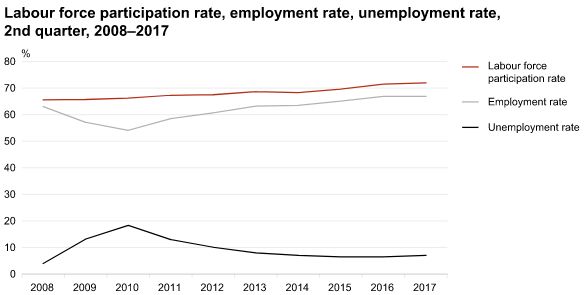Analytics, Employment, Estonia, Labour-market, Markets and Companies
International Internet Magazine. Baltic States news & analytics
Friday, 26.12.2025, 09:08
Labour force participation rate at highest for 20 years in Estonia
 Print version
Print versionCompared to the 2nd quarter of 2016, the number of
working-age persons continued its slow decrease, but the number of persons
active in the labour market (the sum of employed and unemployed persons)
remained the same (702,000). The number of employed persons decreased by 3,500
persons and the number of inactive persons by 6,200 persons, amounting in the
2nd quarter of 2017 to 653,500 and 274,000, respectively.
The labour force participation rate increased in the
2nd quarter mainly due to an increase in the number of unemployed persons, one
of the reasons for which is that persons who have thus far been inactive have
become active. As a result of the Work Ability Reform, the number of people
inactive due to illness or injury has decreased in the past couple of years. In
the 2nd quarter, compared to the 1st quarter of 2017, the number of persons
inactive due to illness or injury decreased by 5,700 persons. In the past 10
years, the number of persons inactive due to ongoing studies has shown a steady
decline. This is rather due to an increasing wish to work during studies or
study whilst working than a decline in the number of learners. The continued
decline in the number of inactive older persons (50–74-year-olds) also plays a
part in the highest labour force participation rate for 20 years. The labour
force participation rate for older persons was 60.7% and the unemployment rate
5.1%.

Compared to the 1st quarter of 2017, when the number
of unemployed persons was relatively small, in the 2nd quarter, the number of
unemployed persons increased by 10,600 persons. Compared to the same period of
the previous year, the change is smaller – the number of unemployed persons
increased by 3,700 persons, reaching 49,000, which is less than, e.g., in the
3rd quarter of 2016. The unemployment rate was 5.6% in the 1st quarter of 2017,
7% in the 2nd quarter and 6.5% in the 2nd quarter of 2016. In the 2nd quarter
of 2017, the unemployment rate for Estonians was 5% and for non-Estonians, 11%.
As expected, the employment rate was highest among the
25–49-year-old males (88%). This is one percentage point less than in the 2nd
quarter of 2016. The increase in the employment rate of females of the same age
was less than one percentage point and was 77.3% in the 2nd quarter of 2017.
The share of full-time and part-time employment in the
main job and the share of underemployment has changed in a year by less than
0.5 percentage points. In the 2nd quarter of 2017, there were 5,000 persons in
part-time employment who would have preferred to work more than they did (the
underemployed).
In conclusion, there were minor fluctuations in the
labour market indicators, but nothing unusual, and the 2nd quarter of 2017 did
not bring about any major changes.
The unemployment rate is the share of the unemployed
in the labour force (the sum of employed and unemployed persons). The
employment rate is the share of the employed in the working-age population
(aged 15–74). The labour force participation rate shows the share of the labour
force in the population aged 15–74. The estimates are based on the data of the
Labour Force Survey.
Statistics Estonia has been conducting the Labour
Force Survey since 1995 and every quarter, 5,000 persons participate in the
survey. The Labour Force Survey is carried out by statistical organisations in
all the European Union Member States on the basis of a harmonised methodology.
In Estonia, the main representative of public interest is the Ministry of
Social Affairs, commissioned by whom Statistics Estonia collects and analyses
the data necessary for conducting the statistical activity.








 «The Baltic Course» Is Sold and Stays in Business!
«The Baltic Course» Is Sold and Stays in Business!

